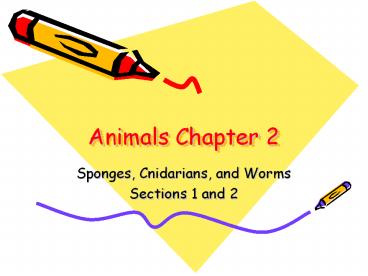Animals Chapter 2 PowerPoint PPT Presentation
1 / 29
Title: Animals Chapter 2
1
Animals Chapter 2
- Sponges, Cnidarians, and Worms
- Sections 1 and 2
2
Definitions
- Nerves carry signals throughout the body
- Ganglia groups of nerves bundled together.
Animals can have a brain and ganglia or just have
ganglia depending on how advanced the animal is - Gut pouch lined with digestive enzymes
- Coelom cavity that allows organs such as the
gut, heart etc to work without interference from
body movement
3
Coelom
4
Ganglion
5
Symmetry
6
Sponges
- Phylum Porifera
- 1st animals on earth
7
Phylum Porifera
- Simplest of all animals
- Asymmetrical
- No head, nervous system, gut or coelom
- Spicules are needle-like splinters that make up
the skeleton - If cells are separated, they can come back
together - Both asexual and sexual reproduction
8
Sponge Anatomy
- Pores - used to pump water into sponge
- Collar Cells filters particles of food from
water and digests them - Osculum hole at the top of the sponge
9
Anatomy of a Sponge
10
Cnidarians
- Jellyfish
- Hydra
- Sea anenome
- corals
11
Phylum Cnidaria
- Radial symmetry
- Complex tissues
- Gut
- Nerve net and nerve ring in medusa form
- If cells get separated, they come back together
- Tentacles covered with nematocysts
- Nematocysts stinging cells
- Sexual and asexual reproduction
12
Body Forms
- Medusa free swimming, mushroom shaped
- Polyp vase shaped, attached to a surface
- Most spend life as polyps but some are born
polyps and turn into medusas
13
Flatworms - Platyhelmenthes
- Planaria
- Flukes
- Tapeworms
14
Characteristics
- Bilateral symmetry
- Nervous system
- Ganglia acts as a brain
- Sensory lobes to detect light and food
- Planaria have a gut
- Fluke and tapeworms are parasites and have no gut
15
Reproduction of Fluke
16
Reproduction of Tapeworms
- Sexual
- Can go from uncooked meat to human
17
Roundworms - Nematoda
18
Roundworm
- Pseudocoelom tube within a tube
- Bilateral symmetry
- Can pick up through the soles of feet, through
dirty hands, through some foods
19
Segmented Worms - Annelida
- Includes earthworms, bristle worms and leeches
- Can live in water or on land
20
Earthworms, Bristle Worms, Leeches
- Earthworms aerate soil (makes tunnels) to allow
water and air in, break down organic matter into
elements that can be used - Bristle Worms all live in water
- Leeches can be scavengers, predators or
parasites, and can be used in medicine
21
(No Transcript)
22
Next
- Earthworm dissection
- Earthworm questions powerpoint
23
Mollusks
- Phylum Mollusca
- Soft bodied usually with a shell or shells
- Three classes
- Gastropods snails and slugs
- Bivalves 2 shells- clams, mussels, etc.
- Cephalopods squid and octopus
24
(No Transcript)
25
Similarities Between Mollusks
26
Feeding
- Different depending on species
- Gastropods have a radula which is like a really
rough tongue and scraps algae, leaves etc. - Bivalves filter feed
- Cephalopods use tentacles to grab prey
27
Circulatory System
- Most mollusks have an open system
- Open system - A simple heart pumps blood into
sinuses - Cephalopods have a closed system
- Closed system blood is circulated through a
closed loop
28
Brains
- Most mollusks have ganglia spread throughout
their body - Cephalopods have a brain where all of the ganglia
are connected
29
Next
- Squid Dissection

